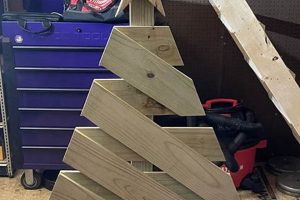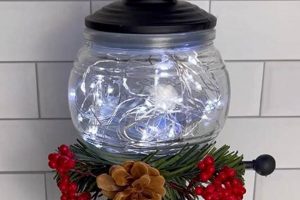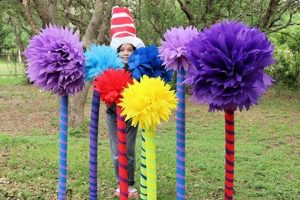The concept involves the creation of Christmas trees using materials readily available or repurposed, offering an alternative to traditional evergreen trees. Projects can range from simple constructions using items such as cardboard or paper to more elaborate designs incorporating wood, fabric, or even recycled materials. These creations serve the same decorative purpose as a standard Christmas tree, providing a focal point for holiday celebrations.
Embracing resourceful and individual expressions, this practice allows for cost savings, reduces environmental impact, and facilitates personalized holiday decor. Historically, resourcefulness in holiday decorations has been a common practice, reflecting economic constraints or a desire for unique ornamentation. Furthermore, crafting holiday decorations can foster creativity and shared activities within families and communities.
The subsequent discussion will explore various approaches to constructing unique Christmas trees, highlighting materials, techniques, and design considerations. Emphasis will be placed on projects suitable for diverse skill levels and aesthetic preferences.
DIY Christmas Tree Project Tips
Successful implementation of these holiday projects requires planning, material selection, and careful execution. The following guidelines offer best practices for achieving aesthetically pleasing and structurally sound results.
Tip 1: Material Assessment. Before commencing any construction, thoroughly evaluate available materials. Consider factors such as durability, weight, and aesthetic suitability. Recycled materials should be cleaned and prepared appropriately.
Tip 2: Structural Integrity. Design the base of the tree with stability in mind. A wide, solid base is crucial to prevent toppling. For taller designs, internal supports or anchoring mechanisms may be necessary.
Tip 3: Scale and Proportion. Adjust the scale of the project to the intended display space. Avoid overwhelming smaller rooms with excessively large creations. Maintain proportional balance between the base, trunk, and upper branches.
Tip 4: Lighting Considerations. Plan for lighting early in the design process. Integrate LED light strings for energy efficiency and reduced heat output. Ensure electrical components are properly insulated and shielded.
Tip 5: Ornament Attachment. Select ornament attachment methods that are secure but non-destructive. Consider using wire, ribbon, or removable adhesive strips to avoid damaging the tree structure.
Tip 6: Color Palette. Establish a cohesive color scheme before decorating. Limiting the palette to a few complementary colors will enhance visual appeal and prevent a cluttered appearance.
Tip 7: Safety Precautions. When using tools or adhesives, adhere to manufacturer safety guidelines. Protect work surfaces and ensure adequate ventilation.
In summary, careful planning and attention to detail are essential for crafting unique and safe holiday decorations. Adherence to these guidelines will enhance the aesthetic appeal and longevity of these projects.
The subsequent discussion will provide diverse design inspirations.
1. Material Availability
Material availability stands as a foundational element influencing the feasibility and design of alternative Christmas tree constructions. Access to suitable components significantly shapes the creative possibilities and practical limitations of such projects.
- Local Resource Accessibility
The immediate surroundings often dictate the primary materials utilized. Coastal regions might favor driftwood, while wooded areas could yield branches or pinecones. Urban environments might necessitate reliance on discarded cardboard, plastic, or metal. This geographic dependence directly impacts the aesthetic and structural characteristics of the resulting tree.
- Seasonal Material Variations
The time of year influences the availability of natural elements. Autumn may provide an abundance of fallen leaves suitable for decorative purposes, while winter could limit options to evergreen boughs or manufactured substitutes. These seasonal fluctuations require adaptability in design and material selection.
- Repurposed Material Streams
The accessibility of recycled or repurposed materials significantly impacts sustainability and cost-effectiveness. Access to recycling centers, salvage yards, or community donation programs expands the range of potential components. This promotes environmentally conscious practices while reducing project expenses.
- Budgetary Constraints and Commercial Options
The available budget directly dictates the feasibility of acquiring materials. While free or low-cost options are often preferred, budgetary allowances can facilitate the purchase of specialized components, such as lighting systems, decorative elements, or structural supports. This economic factor influences both the aesthetic quality and structural integrity of the design.
Ultimately, material accessibility acts as a primary determinant in shaping both the creative possibilities and practical constraints of these projects. A comprehensive understanding of local resources, seasonal variations, repurposing options, and budgetary limitations is essential for successful project implementation and overall design impact.
2. Structural Stability
The relationship between structural stability and alternative Christmas tree designs is fundamental to the project’s success and safety. The method of construction and the properties of the materials directly determine the load-bearing capacity and resistance to external forces such as wind or accidental contact. Lack of stability leads to collapse, posing a risk of damage to surrounding objects and potential injury.
The materials chosen for the project must possess sufficient strength and rigidity to support their weight and any attached ornaments. For example, a tree constructed from stacked books requires a robust central support to prevent buckling, while a design utilizing branches necessitates careful selection of branch thickness and secure attachment methods. Furthermore, the base of the tree must provide adequate support to prevent tipping. A wide base, weighted with sand or other heavy materials, enhances stability. Examples of unstable structures include trees constructed from lightweight plastic bottles without internal support and top-heavy designs lacking a solid foundation. Conversely, a tree built with interlocking wooden panels or a sturdy metal frame exhibits high structural integrity.
In summary, structural stability is a crucial engineering consideration in the design and construction of Christmas tree projects. A thorough assessment of material properties, load distribution, and base support is essential to ensure the creation of a safe, durable, and aesthetically pleasing decoration. Ignoring these principles undermines the project and creates safety hazards.
3. Space Constraints
Space limitations exert a significant influence on the conceptualization and execution of alternative Christmas tree designs. Reduced square footage necessitates a departure from traditional, large-scale evergreen trees, prompting the adoption of space-saving solutions. These constraints are not merely restrictive but serve as catalysts for innovative designs that prioritize verticality, modularity, and miniaturization. The size of an apartment living room, for instance, directly influences the maximum permissible dimensions of a tree, leading to the creation of wall-mounted or corner-fitting alternatives. In contrast, a spacious foyer allows for larger, more elaborate designs that might be impractical in a confined setting.
The impact of spatial limitations manifests in various design adaptations. Wall-mounted trees, crafted from branches or strung lights, occupy minimal floor space while maintaining a festive presence. Corner trees, triangular in cross-section, maximize utilization of otherwise unused areas. Tabletop trees, often constructed from felt or paper, offer a compact and portable solution for smaller dwellings. Furthermore, digital projections of trees onto walls represent a completely space-agnostic approach, eliminating the physical footprint altogether. The choice of materials is also affected; heavier materials like wood may be avoided in favor of lighter alternatives such as cardboard or fabric to minimize the perceived bulkiness of the structure.
The understanding of space limitations is paramount in generating designs that are both aesthetically pleasing and practically feasible. By acknowledging and addressing the spatial context, designers can create alternative Christmas tree options that seamlessly integrate into the environment without compromising functionality or visual appeal. These considerations also extend to storage; compact designs are often preferred due to their ease of disassembly and storage during the off-season. This synergistic relationship between spatial awareness and creative problem-solving underpins the efficacy and desirability of alternative tree options in modern living spaces.
4. Aesthetic Cohesion
Aesthetic cohesion serves as a critical determinant of success in the execution of DIY Christmas tree ideas. It dictates the harmony and visual appeal of the final product, influencing the overall perception and impact of the decorative piece within its environment. A lack of cohesion results in a visually jarring or unappealing outcome, diminishing the intended festive atmosphere. Conversely, a well-executed aesthetic creates a unified and pleasing visual statement, enhancing the holiday spirit.
The influence of aesthetic cohesion can be observed in numerous examples. A tree constructed from mismatched fabric scraps, despite demonstrating resourcefulness, might appear chaotic without a unifying color scheme or thematic element. In contrast, a similar project employing a carefully selected palette of complementary colors and consistent fabric patterns achieves a refined and deliberate aesthetic. Similarly, a tree adorned with a hodgepodge of ornaments lacking a common style or scale can appear cluttered. Conversely, a tree decorated with ornaments of a similar color family or theme, such as vintage glass ornaments or handcrafted wooden pieces, presents a cohesive and visually appealing composition. An example includes a tree made of stacked wooden pallets, painted in varied but harmonious shades of green, and adorned with minimalist metal ornaments, achieving an industrial-chic aesthetic. Another example is a wall-mounted tree created with intertwined fairy lights and photos, using a warm monochromatic filter to create a vintage, nostalgic feel.
Achieving aesthetic cohesion in tree projects requires careful planning and consideration. It entails selecting a consistent color palette, establishing a thematic direction, and curating materials and ornaments that align with the chosen aesthetic. Understanding the principles of design, such as balance, proportion, and rhythm, is essential for creating a visually harmonious outcome. The practical significance of this understanding lies in the ability to transform readily available materials into visually compelling and emotionally resonant holiday decorations, thereby amplifying the impact of the DIY endeavor. Overcoming the challenge of material limitations through resourceful design thinking ensures the realization of the intended aesthetic vision.
5. Cost Effectiveness
The economic consideration of cost-effectiveness is a primary driver in the selection of alternative Christmas tree designs. The expense associated with procuring a traditional evergreen tree, whether real or artificial, presents a tangible economic barrier for certain households. Moreover, recurring costs related to tree stands, disposal fees (for real trees), and storage space (for artificial trees) contribute to the overall financial burden. DIY Christmas tree projects offer a means to mitigate these expenditures by utilizing readily available, repurposed, or inexpensive materials. The fundamental principle is the substitution of commercially produced products with self-made alternatives, thereby reducing the financial outlay associated with holiday decorations. For example, a tree constructed from repurposed cardboard boxes and adorned with handmade ornaments significantly minimizes cost compared to purchasing a pre-decorated artificial tree. The direct consequence of this substitution is a noticeable reduction in holiday spending, particularly beneficial for individuals or families operating within strict budgetary constraints. This approach also underscores a commitment to responsible consumption by minimizing the demand for newly manufactured goods and promoting resourcefulness.
The importance of cost-effectiveness extends beyond mere financial savings. It fosters creativity and resourcefulness, encouraging individuals to reimagine everyday materials in novel ways. This, in turn, can lead to the development of unique and personalized decorations that reflect individual tastes and values, moving away from mass-produced uniformity. The practical significance is evident in community-based initiatives where workshops are organized to teach cost-effective decoration techniques, empowering participants to create festive decorations without incurring significant expenses. Another practical application involves educational settings, where children are encouraged to create Christmas trees from recycled materials, promoting environmental awareness and financial responsibility. These initiatives highlight the transformative potential of cost-effective DIY projects, extending their impact beyond individual households to broader community engagement and educational opportunities. These types of projects often showcase great cost-saving outcomes.
In conclusion, the pursuit of cost-effectiveness is integral to the appeal and accessibility of alternative Christmas tree designs. It not only reduces financial strain but also promotes creativity, resourcefulness, and community engagement. The understanding and application of cost-saving principles are essential for maximizing the benefits of these projects, transforming economic constraints into opportunities for innovation and self-expression. Although some challenges related to material sourcing and design expertise may exist, the overall advantages of cost-effective DIY decorations outweigh these obstacles, solidifying their position as a viable and sustainable alternative to traditional commercial options.
Frequently Asked Questions
This section addresses common inquiries and misconceptions surrounding the implementation and suitability of alternative Christmas tree projects.
Question 1: Are self-made Christmas trees structurally sound?
Structural integrity varies significantly based on design and material selection. Proper planning, robust construction techniques, and the utilization of durable materials are essential for ensuring stability. Failure to adequately address structural concerns can result in collapse and potential hazards.
Question 2: What materials are suitable for building an alternative Christmas tree?
A wide array of materials can be employed, including wood, cardboard, fabric, metal, and recycled plastics. The suitability of a material depends on its strength, weight, aesthetic appeal, and ease of manipulation. Careful consideration should be given to the material’s flammability, particularly if incorporating lighting elements.
Question 3: How do space constraints impact design options?
Limited space necessitates the adoption of compact and often vertically oriented designs. Wall-mounted, corner-fitting, or tabletop trees offer viable alternatives to traditional, full-sized trees. Strategic utilization of available space is paramount.
Question 4: What is the cost comparison between DIY and commercially available trees?
DIY projects generally offer significant cost savings, particularly when utilizing repurposed or readily available materials. However, the cost can escalate with the incorporation of specialized materials, elaborate lighting systems, or intricate designs. Budget planning is crucial.
Question 5: Can DIY Christmas trees be as aesthetically pleasing as traditional trees?
Aesthetic appeal is subjective and dependent on design execution. Careful attention to color palettes, thematic consistency, and overall craftsmanship is essential for creating a visually appealing alternative. Cohesion and balance are key factors.
Question 6: Are there safety considerations to keep in mind?
Safety is paramount. When working with tools or adhesives, always adhere to manufacturer guidelines. Ensure that electrical components are properly insulated and shielded to prevent fire hazards. Select flame-retardant materials where possible. Weight distribution and stability should be carefully considered to prevent toppling.
In summary, DIY Christmas tree projects offer a viable and often cost-effective alternative to traditional options, provided that adequate attention is paid to structural integrity, material selection, spatial limitations, aesthetic cohesion, and safety precautions.
The subsequent discussion will explore inspirational examples and showcase successful DIY Xmas Tree Ideas.
Conclusion
The preceding exploration of diy xmas tree ideas has highlighted diverse considerations ranging from material selection and structural integrity to aesthetic cohesion and cost-effectiveness. The viability and appeal of these projects hinge on a comprehensive understanding of these factors and their careful implementation within specific contexts.
The continued exploration and refinement of alternative designs hold the potential to redefine holiday traditions and foster more sustainable and personalized celebrations. Careful planning and skillful execution are paramount to transforming conceptual diy xmas tree ideas into tangible and aesthetically pleasing realities. The future of holiday decor lies in the innovative application of available resources and a commitment to creative problem-solving.







